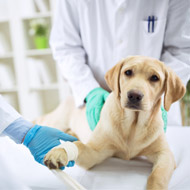
Study measures force on front legs from three different boot heights
Allowing dogs to jump out of big cars with high boots may put undue pressure on their front legs and increase their risk of injury, according to new research.
Although dog owners are required by UK law to restrain their animal when travelling in a vehicle, no legislation exists for safe entry and exit from a car boot or back seat.
To see if different car boot heights are linked to excess pressure loading, researchers organised an experiment where 15 healthy dogs jumped three times. Each jump was from a platform set to a different boot height: 0.55, 0.65 and 0.75 meters.
The team measured the forces involved for each of these jumps and found that the pressure on the dog’s front legs rose significantly as the ‘boot’ height increased. Between the 0.55 and 0.65 metre heights, the pressure increased by just under 13 per cent. With a further 10cm rise in height, this pressure rose by 11 per cent.
The researchers stress that further research is required to investigate the link between this type of pressure and the type of front leg injuries commonly seen in dogs. However, they conclude:
“This study provides the first objective evidence to support the commonplace belief that allowing dogs to repeatedly jump clear from vehicles with high boot compartments may be inadvisable.”
The study, Peak forelimb ground reaction forces experienced by dogs jumping from a simulated car boot, is published in Vet Record.



 The RCVS has announced a new version of its 1CPD mobile app, with enhanced features for veterinary surgeons and veterinary nurses to record their continuing professional development.
The RCVS has announced a new version of its 1CPD mobile app, with enhanced features for veterinary surgeons and veterinary nurses to record their continuing professional development.